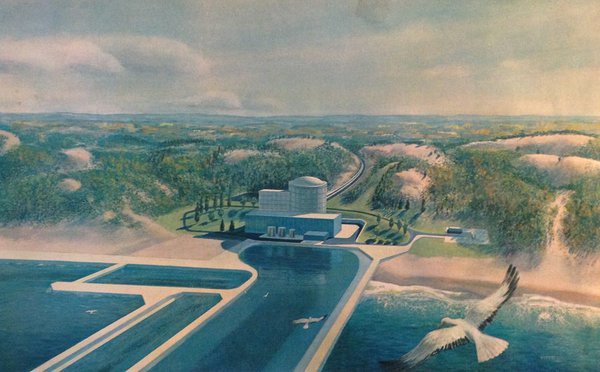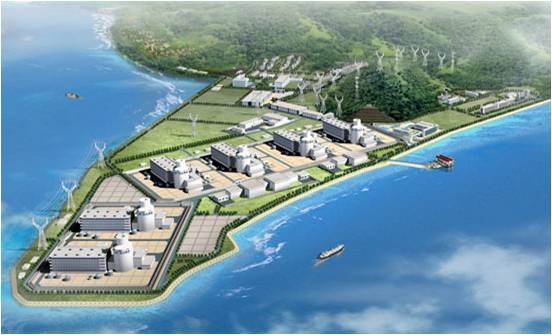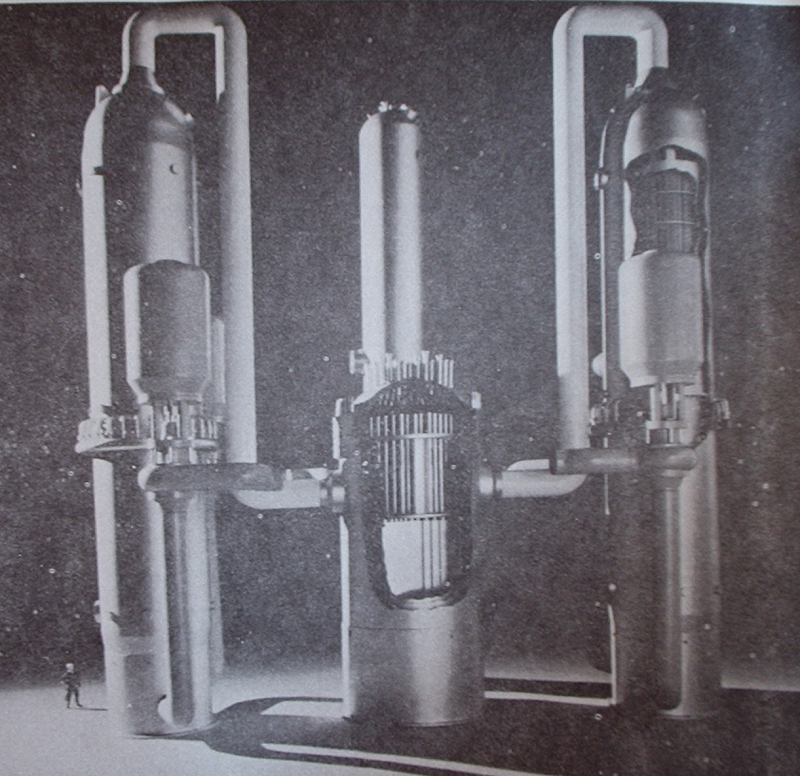"Building Nuclear" - A Guide for Writers
Reporting this week and last on the financial problems of Toshiba has variously contained the phrases "building reactors," "building nuclear plants," and many others. It seems that the general press is confused (and probably rightly so) when it comes to the terminology used to describe the nuclear power plant construction business. So, here I'll provide a guide to the process and terms used in the industry and describe the various players.

Artist's concept of Palisades Nuclear Plant. This is a nuclear power plant, or station, with a single unit. In some parts of the world, the term "power block" or "block" is synonymous with the word unit, meaning a combination of a nuclear reactor and its generating system. A nuclear power plant (NPP) or, said another way, a nuclear generating station may have anywhere from one to eight units. Illustration from brochure in Will Davis library.
The Players
Owner: This part of the construction triangle is obvious-it's the utility company that is buying the nuclear power plant. This company has to provide land for the plant, pay to have it constructed, operate it, and connect the plant to its grid. Owners of nuclear plants can be single companies or groups of companies acting together either as joint owners or separate stand-alone companies with joint ownership (either of which arrangements spreads the costs). Owners generally make a decision that they need more generating capacity first, then they conduct studies to determine which way to get that added power. If the studies show that a nuclear power plant is the best option, then a process is started with other contractors. I write more about owners below.
Architect-Engineer: This is the company that designs the power plant. In most cases, once an owner has made a decision to build a nuclear plant it hires an architect-engineer (A-E) to come on board for the project. The A-E may or may not assist the utility in selecting a particular nuclear technology. Once the nuclear steam supply system (NSSS) and other particulars have been specified, the A-E designs the power plant. This will inevitably include many, many thousands of pages of drawings, and the number of considerations, specifications, and drawings has traditionally always increased. The drawings will have to match specifications provided by both the reactor vendor and the owner as to specifics for the particular project. The A-E needs to look at, for example, would a particular job include a cooling tower, or will a river be used? The job of the A-E is later closely tied with the next entity we'll investigate. (1)
Constructor: This is the company that builds or supervises the construction of the nuclear power plant. Typically the constructor hires many dozens of subcontractors to complete the actual jobs of pouring concrete, fitting piping, running wires, etc. The constructor builds according to the drawings supplied by the A-E and acts based upon the availability of the parts needed for installation. Tremendous troubles can be caused by a constructor building ahead of the receipt of the plans, only to find out that part of the work was done in error once the final drawings show up. This would lead to the work being ripped out and redone. Still other times, the actual work itself may be faulty and fail inspection, which would lead to removing and replacing the work. Of course, late delivery of drawings and specifications from the A-E will also lead to significant delay.
Some of the very large firms, such as Bechtel, Stone & Webster, EBASCO, United Engineers & Constructors, and some others offered not only A-E services but construction management services as well. Some owners felt that this was best to have the same company in charge of both parts of the overall project. However, at the height of nuclear plant construction in the United States, with so many units continuously under construction, ordered, and announced, it was impossible at any arbitrary moment to guarantee that a particular selected company had the resources available to tackle both jobs on any prospective contract.
In some cases, utility companies (owners) have traditionally designed and even constructed their own power plants and facilities. This tradition carried into the nuclear power plant era when owners did not hire A-E or constructor services. Tennessee Valley Authority (TVA) and Duke Power are probably the two best known examples, but Pacific Gas and Electric (PG&E) designed and built the Diablo Canyon nuclear plant itself. In other cases, the utility did part of the work itself and contracted out the rest. For example, Detroit Edison (now DTE) designed Fermi Unit 2 but contracted out the construction of the plant. In other cases, usually disastrous, the owners have attempted to build the plants without hiring a dedicated constructor, spreading out the construction contracts themselves. For the most part, though, the triad of owner/A-E/constructor holds valid.

Hope Creek, shown here, was designed as a nuclear power station with two units. There are thus two reactors, which are inside the can-shaped containment buildings, and there are also two turbine-generators inside the long turbine building. Palisades, seen earlier, used 'open cycle' cooling (water coming from and returning to a lake) while Hope Creek (seen here) uses 'closed cycle' cooling, with cooling towers. Hope Creek was eventually completed with only one unit. Illustration from brochure in Will Davis library.
Other Important Players
Reactor Vendor: These are the companies that, frankly, usually get all the press. These are the companies that actually design and construct the nuclear reactor itself, and the very closely related NSSS. The NSSS is built inside the containment building and has many interfaces with the rest of the plant. The two most important interfaces are the steam it sends out through pipes that gets used to generate electricity, and the water that comes back in to replace that which was turned into steam. Of course, there are a large number of control and indication connections to be made as well. As important as the NSSS and reactor vendor are, they are not the entities that set the overall power plant design-that is up to the A-E and the owner. Over time, there has been an increasing tendency to standardize and to duplicate complete power plants from one location to the next. This is the norm today, so that it is appropriate to talk about a particular design in terms of the reactor design itself. However, in the "old days" (certainly regarding all the nuclear plants operating in the United States today), the general speech is not that a plant is a "Westinghouse plant," but rather a "Bechtel plant" or a "Stone & Webster plant," because these A-E firms set the overall design of the plant into which an NSSS and many other components must be integrated. (2)
Very recently, reactor vendor/A-E teams have appeared, such as with the Westinghouse AP1000, so that the nuclear units being built at more than one location are theoretically identical (except of course for any specific owner-ordered customizable items). Further, in some countries where the industry is state-controlled or vertically integrated, there is no option as to who will design a power plant, so that all of them will more or less be the same (perhaps with incremental changes over time). (3)

Sanmen NPP in China, shown in this preconstruction artwork, is intended to be a six unit nuclear generating station. Artwork courtesy State Nuclear Power Technical Corporation.
Regulator: The last significant player to mention is the regulator, or a nation's official body charged with ensuring nuclear plant safety. Many millions of words have been written about regulators, but for the purpose of this discussion we will just say that the regulator's inspections of the nuclear plant construction must be passed, and it has authority to halt work. Changes to regulations while a plant is already under construction can contribute significant delay if the regulator forces the changes on the plant's completed work.
In order to be clear on the terms-especially given the recent reporting and apparent confusion-here is one final explanatory example for clarity.
 Above we see, from a print in my library, a rather generic illustration meant to convey the appearance of what might have been considered in 1969 or so to have been the normal appearance of a single unit nuclear power station equipped with a Babcock & Wilcox NSSS. Such a piece of art is generally the product of an A-E, which is responsible for the overall design of the plant. What we are seeing here is not a "reactor," since we cannot see the reactor at all because it's inside the white, roughly cylindrical containment building. This is instead a "unit," or if you're European a "power block." A nuclear power plant, also known as a nuclear generating station, may have one or multiple units. They may be built connected to each other (see the Hope Creek illustration earlier) or they may be completely stand-alone and separate (see the Sanmen illustration).
Above we see, from a print in my library, a rather generic illustration meant to convey the appearance of what might have been considered in 1969 or so to have been the normal appearance of a single unit nuclear power station equipped with a Babcock & Wilcox NSSS. Such a piece of art is generally the product of an A-E, which is responsible for the overall design of the plant. What we are seeing here is not a "reactor," since we cannot see the reactor at all because it's inside the white, roughly cylindrical containment building. This is instead a "unit," or if you're European a "power block." A nuclear power plant, also known as a nuclear generating station, may have one or multiple units. They may be built connected to each other (see the Hope Creek illustration earlier) or they may be completely stand-alone and separate (see the Sanmen illustration).
If we could see the NSSS, which includes the reactor and the steam generators (since, in this case, the NSSS is a pressurized water reactor type), it would look like the model below, also from a print in the author's collection.
 Above we see a typical Babcock & Wilcox NSSS, known as the Babcock-177 (because the nuclear reactor core has 177 fuel elements). The center item is actually the reactor vessel, and inside is the reactor. The reactor vendor, Babcock & Wilcox, was responsible for either manufacturing or outsourcing the manufacturing of all the needed equipment. It supplied drawings and specifications to the A-E for a plant, and then the equipment was sent to the site for the constructor(s) to install. This NSSS provides steam that is piped into the non-nuclear portion of the plant, where a large turbine generator converts the energy into electricity for the grid.
Above we see a typical Babcock & Wilcox NSSS, known as the Babcock-177 (because the nuclear reactor core has 177 fuel elements). The center item is actually the reactor vessel, and inside is the reactor. The reactor vendor, Babcock & Wilcox, was responsible for either manufacturing or outsourcing the manufacturing of all the needed equipment. It supplied drawings and specifications to the A-E for a plant, and then the equipment was sent to the site for the constructor(s) to install. This NSSS provides steam that is piped into the non-nuclear portion of the plant, where a large turbine generator converts the energy into electricity for the grid.
The terminology here seems clear enough, but is easily and quickly garbled and easily misinterpreted. When the Toshiba president and CEO said that the company was considering halting constructing in order to isolate itself from risk, what he was referring to was the A-E and constructor functions that the company itself had built up. As explained before, traditionally the reactor vendors never had this function internal to themselves. This development places the reactor vendor in a position of exposure to construction risks, and it is the company's intent to revert to the position of supplier of systems. That is, at least, so far as the hints given by the company's management indicate.
Hopefully this guide will prove useful to writers of all kinds.
Footnote on construction arrangements: During the period of the U.S. Atomic Energy Commission's Power Demonstration Reactor Program, nuclear plants were built under a dual-construction arrangement wherein the AEC owned the nuclear portion of the plant (the NSSS and reactor building or containment) and the utility owned the turbine generating portion, usually abbreviated as BOP for Balance of Plant. In this arrangement, the AEC had its own A-E and constructor for the nuclear portion, and the utility had its own A-E and constructor for the non-nuclear portion (if the plant was not a "hook-on" to an existing steam plant). Later, a couple of the reactor vendors felt that jump-starting the commercial nuclear field would be helped by offering to the utilities "turnkey" nuclear power plants, which was like buying an already built new car-just get in, turn the key, and off you go. In these arrangements, the reactor vendor hired the A-E and the constructor, which worked for the reactor vendor. A flat fee was charged to the owner, who provided the land and connections for the plant's services and output. Only a few turnkey plants were built before the conventional owner/A-E/constructor setup took over, which was used for the vast majority of nuclear plants ordered in the United States.
For much more detail on nuclear plant construction, and cost and schedule overrun, click here.
(1) The biggest and most well-known A-E firms that took part in the build of nuclear plants in the United States were, in no order, Bechtel, Stone & Webster, United Engineers & Constructors, EBASCO, Gibbs & Hill, Gilbert Associates, Burns & Roe, Fluor, and Sargent & Lundy.
(2) The biggest and most well-known US reactor vendors were/are Westinghouse, General Electric, Combustion Engineering, Babcock & Wilcox, Atomics International (Div. of North American Aviation), General Atomic (originally a division of General Dynamics, later owned by Gulf Oil), and Allis-Chalmers.
(3) Standardized, and completely duplicate nuclear plant construction did occur in the United States with the SNUPPS project; see here. A stillborn duplicate project was Duke Power's Project 81; see here. In a number of other cases, A-Es worked off a standard set of initial drawings to design nuclear power plants for more than one owner.
 Will Davis is Communications Director and board member for the N/S Savannah Association, Inc. He is a consultant to the Global America Business Institute, a contributing author for Fuel Cycle Week, and he writes his own popular blog Atomic Power Review. Davis is also a consultant and writer for the American Nuclear Society, and serves on the ANS Communications Committee and on the Book Publishing Committee. He is a former U.S. Navy reactor operator and served on SSBN-641, USS Simon Bolivar.
Will Davis is Communications Director and board member for the N/S Savannah Association, Inc. He is a consultant to the Global America Business Institute, a contributing author for Fuel Cycle Week, and he writes his own popular blog Atomic Power Review. Davis is also a consultant and writer for the American Nuclear Society, and serves on the ANS Communications Committee and on the Book Publishing Committee. He is a former U.S. Navy reactor operator and served on SSBN-641, USS Simon Bolivar.


